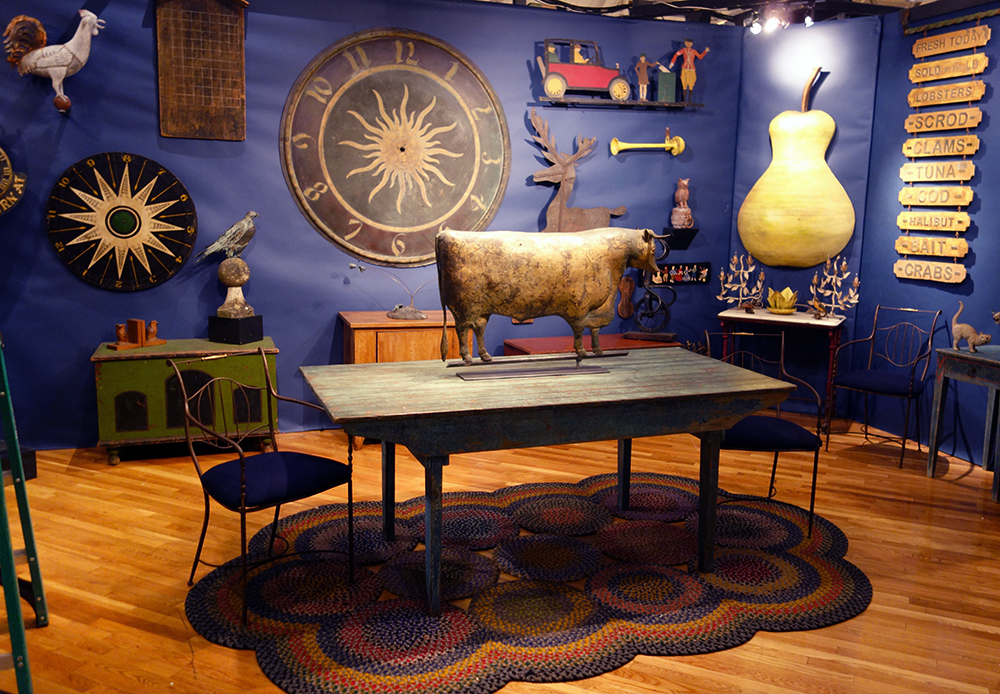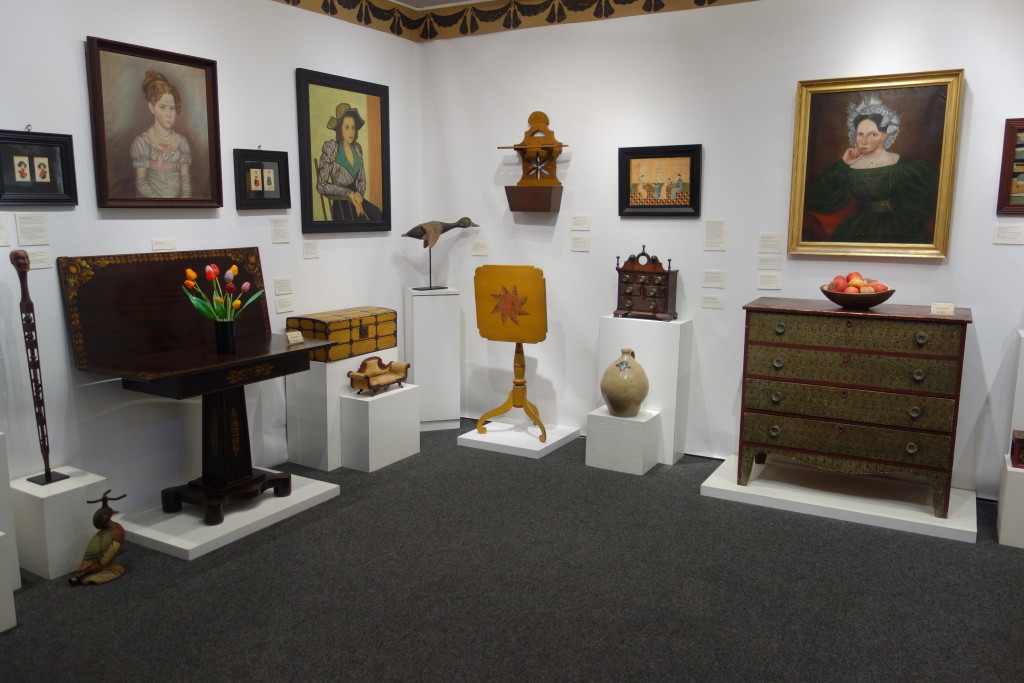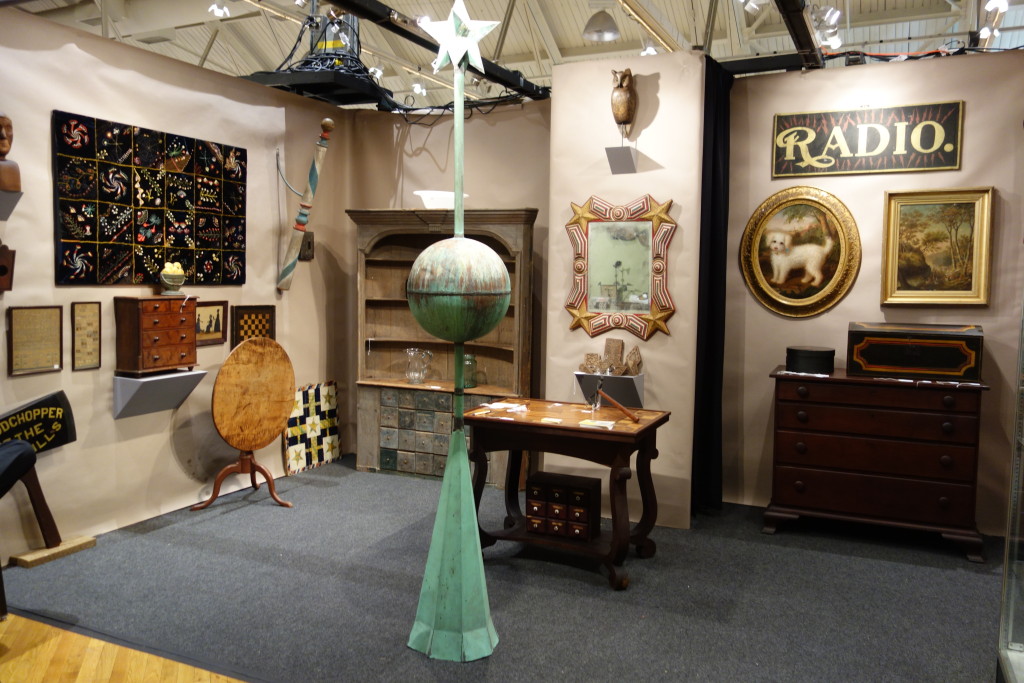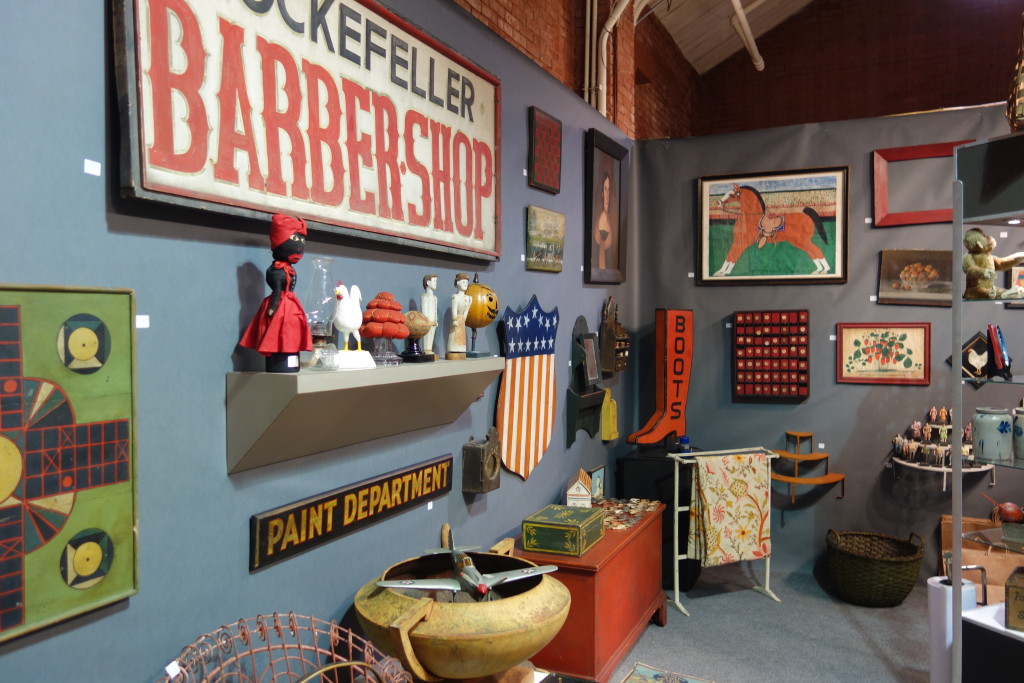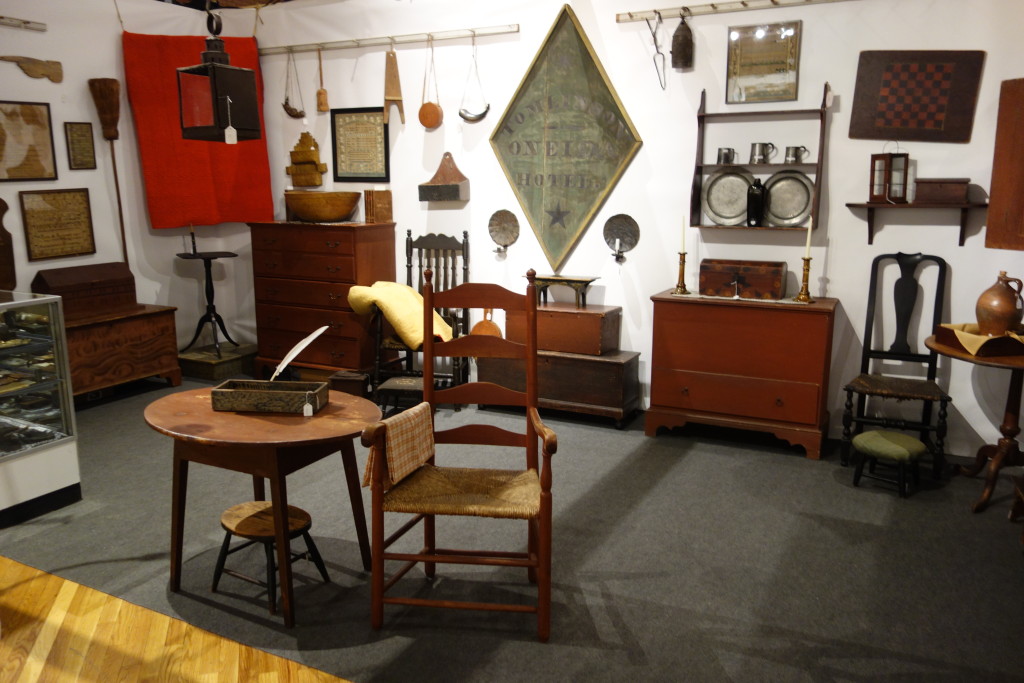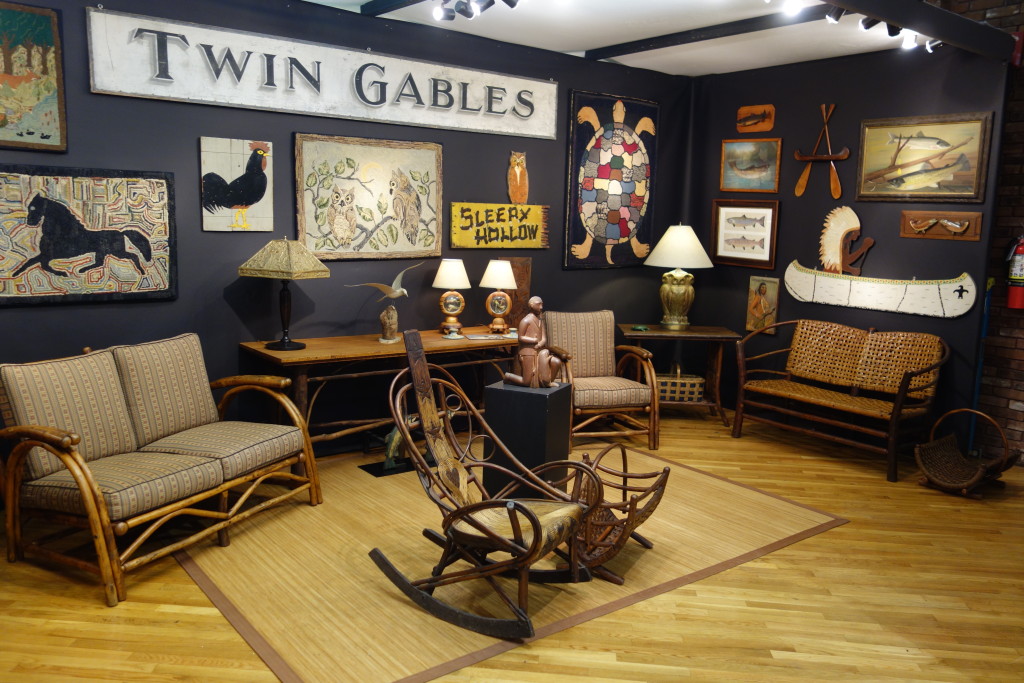Review by W.A. Demers, Photos by R. Scudder Smith and W.A. Demers
MANCHESTER, N.H. – Howard Oedel, dealer/progenitor of the New Hampshire Antiques Show, remembers cobbling together 17 antiques dealers for the first event that took place on the second floor of a roadside motel just off Interstate 93 in Concord, N.H., in 1957. “It cost $3 to be a member,” he recalled. His eyes lighting up, he added, “There were great antiques back then. I could go out in a pickup truck and at the end of the day come home with some wonderful things.”
The former president of the New Hampshire Antiques Dealers Association (NHADA), now 97 and accompanied by a caregiver, spryly cut the green ribbon at the entrance to the 2017 show – the 60th Anniversary edition – accompanied by New Hampshire Governor Christopher T. Sununu, Manchester Mayor Ted Gatsas and NHADA members – just before hordes of eager shoppers, who had snaked around the foyer of the ballroom and lined up at the street entrance, rushed inside to acquire the seemingly endless treasures on offer.
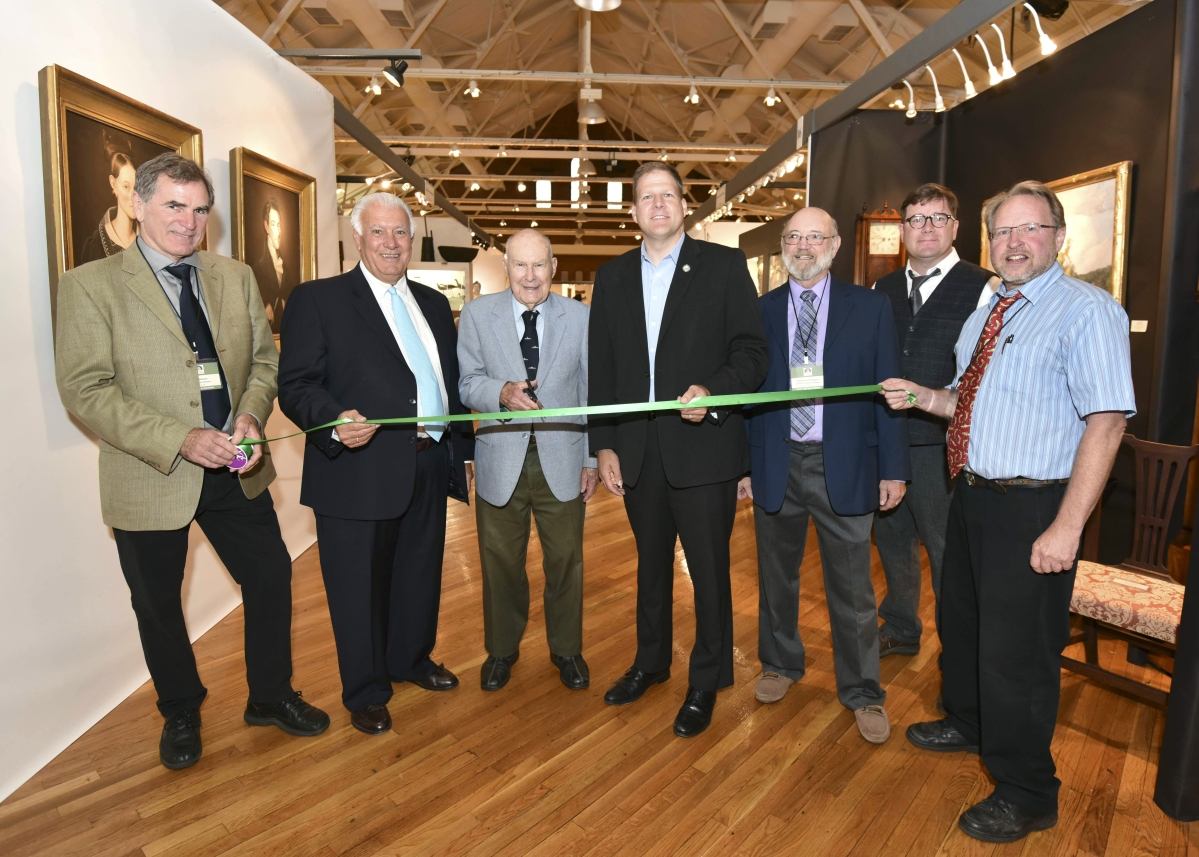
From left, NHADA treasurer Peter Sawyer, Manchester Mayor Ted Gatsas, show founder Howard Oedel, New Hampshire Governor Chris Sununu, NHADA board president Tommy Thompson, show chairman Josh Steenburgh and Scott Bassett.
Sponsored, organized and operated by NHADA members, the three-day event is one among a septet of antiques shows taking place in the area during Antiques Week in New Hampshire. It culminates the week’s action, this year running August 10-12, so many consider it the “premier summer show,” like Marlborough, N.H., dealer Tom Longacre doing his 40th stint, who, after making about 30 sales, including an early Nineteenth Century ten-drawer spice chest in old red, painted boxes, trade signs, barber pole, Windsor chair and watercolor theorem, pronounced it “excellent.”
On the following pages, Antiques and The Arts Weekly provides just a small sampling of the vast and incredible array of freshly picked folk art, porcelain, country and formal furniture, paintings and prints, glassware, metalware, pottery and much more on offer by the show’s 67 exhibitors.
An apothecary chest in original red paint and from the first half of the Nineteenth Century had been pulled out of Pennsylvania and was being shown by Steven F. Still of Manheim, Penn. The drawers, some with restoration, numbered 21, with two rows of five on top, two rows of four in the center and a row of three at the bottom. The dealer also showed a framed group of 28 miniature presidential portraits by William A. Patterson (1865-1939), the William Harding portrait signed by the artist and dated 1920. This being the sweet-spot of summer, however, the most resonant item in the booth was the “Cat Game” by Elizabeth Fearne Bonsall (1861-1956). “Beppie,” as she was nicknamed, created this wonderful game for the Rolfie family to play at their Chadwick beach house on the New Jersey seashore. It consisted of 30 drawings of cats in a variety of poses, each one with a cluing question and each answer having the word “cat” in the answer. “A tall weed?” CATtail; “A religion? CATholic; “A sauce?” CATsup – you get it.
Many of the NHADA dealers are longtime veterans. For Scott DeWolfe and Frank Wood, however, whose Alfred, Maine, firm DeWolfe & Wood Rare Books is a member of the Antiquarian Booksellers Association of America, this show was their second. And although they are primarily booksellers, they also collect and show Shaker material, such as an early child’s chair, circa 1840, that had probably come from the Canterbury or Sabbath Day Lake community. Over it was draped a child’s wool “Dorothy” cloak, circa 1930s. A remarkable collection of handwriting samples, circa 1814-20, from a time when penmanship was a prized skill, had come from a school in Roxbury, Mass. As a by-product of stitching together words and sentences, one of the children went on to become a tailor. And a sample by Benjamin Willard was almost certainly by a relative of the famous clockmaking family. Here, too, was the first published song of the US Civil War. Published three days after Fort Sumter was fired on, the 1861 song was George F. Root’s “The First Gun is Fired. May God Protect the Right!”
Peter Sawyer, Exeter, N.H., sold the centerpiece of his booth, an exceptional Simon Willard tall case clock that had a painted mosquito on the dial and refined construction details. Rarely do Simon Willard clocks of this quality come on the market. It was the most expensive thing in his booth. He said he also sold a Chippendale mahogany wing chair covered in gold fabric, Portsmouth, N.H., circa 1790, other clocks, paintings and numerous smalls. “Business has really perked up,” he said. “The buyers were enthusiastic and we made more sales.”
A trio of gems in the booth of Frank and Barbara Pollack American Antiques & Art, Highland Park, Ill., and Sunapee, N.H., included an exuberantly painted and decorated two-drawer lift top blanket chest, probably from Vermont, circa 1835-40, a collection of silk fruits in a wood bowl, circa 1890, that included a rare tiny cucumber, and an oil on canvas portrait of a lady in a green dress wearing an elaborate bonnet, circa 1830.
Pam Boynton, who died at home at the age 87 this past March, was a larger-than-life figure to the tight-knit community of collectors, dealers and auctioneers who knew and loved her. Her daughter, Martha Boynton, Townsend, Mass., mounted an affecting display of some of her mother’s favorite things at this show. These included a red bucket bench with two shelves, probably Pennsylvania, a prancing horse weathervane with flying tail by an unknown maker but unmistakably similar to well-known examples by Jewell and a rare large squeak toy that Martha said was among her mother’s favorites. Plans are underway to offer Pam Boynton’s collection at auction next spring, possibly at Skinner in Boston.
Gail and Don Piatt, Contoocook, N.H., were having a bittersweet experience at the show. Doing their final NHADA outing, the couple sold expensive smalls and small pieces of painted furniture. “Original surface sells,” said Gail. “It was quite a send-off for us.”
There were many great things on display at Axtell Antiques, presided over by the Deposit, N.Y., dealer “Smitty” Axtell. These included an extremely rare butter stamp, circa 1780, featuring a compound flower design by Thomas Affleck of Philadelphia furniture fame, a pair of miniature candlestands from New Hampshire, circa 1790, remarkable for the fact that they resembled actual hogscrapers right down to the candles, wicks and stands but were entirely handcarved from pine. A mantel designed by Ezra Weeks, who also designed Gracie Mansion in New York City, had been built by Eliphalet Thompson in 1809 in Deposit from North American pine.
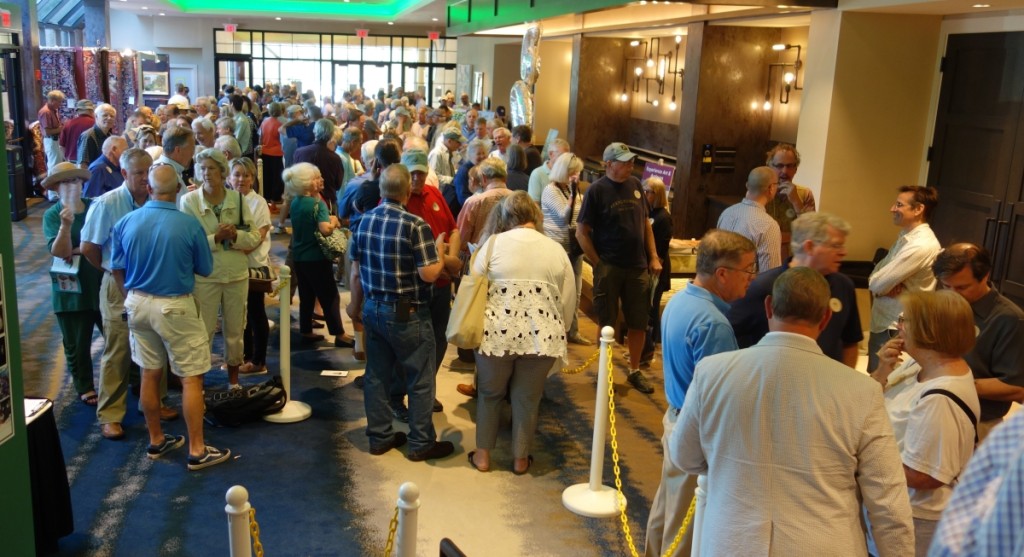
The line starts as early as 4 am for the show. These people were the first in line, with the remainder of the line stretching down the block outside.
Oil on panel Belknap portraits, dated 1822, were a key item at Scott Bassoff and Sandy Jacobs. The Swampscott, Mass., dealer also showcased a dollhouse cupboard from Baltimore, which although made in the 1840s had survived in such fabulous condition that it could be a really neat cupboard today.
Tom Jewett and Butch Berdan, Newcastle, Maine, have been champing at the bit since last summer waiting for the 60th Anniversary show and set aside several objects for it. A graphic “Soda, Ice Cream & College Ices” sign from about 1870 had come out of a Peterborough, N.H., drug store, while a demilune table with unusual backsplash from about 1835 exhibited great red paint. And a wall clock shelf with a handcarved bird ascending to an egg-gilded nest, found in Indiana but probably from Pennsylvania, dated to about 1870-80.
A group of portraits “confidently attributed” to Ruth W. Shute during her time in Saint Albans, Vt., and Plattsburgh, N,Y, 1834-35, according to Jeff and Holly Noordsy of Cornwall, Vt., were among the highlights in the dealers’ booth, along with several paint decorated tinware boxes with flower and fruit motifs and a brilliant blue Sandwich, Mass., GI-29 blown three-mold creamer, circa 1830.
Rare books and historical manuscripts are the focus of Manchester dealer Resser-Thorner Antiques. Bibliophile candy offered here included a series of Seventeenth and Eighteenth Century books that contained a law book printed in 1746 owned by General John Sullivan (1740-1795), an American general in the Revolutionary War, a delegate in the Continental Congress, governor of New Hampshire and a United States federal judge, with his bookplate from October 1787. One of the earliest items the dealer brought was a 1657 work printed in London titled The Application of Redemption by Thomas Hooker (1586-1647), pastor of Hartford, Conn.
Facing showgoers as they entered the main hall was a proud Dentzel rooster carousel figure from a private Vermont collection. The 51-by-56-by-11-inch figure of carved basswood, circa 1894-1902, was being shown by Olde Hope Antiques, New Hope, Penn. Among the dealer’s showcase of furniture, paintings, sculpture, textiles and accessories was a wonderful turtle quilt from Georgia, possibly African American, from the late Nineteenth or early Twentieth Century, 76 by 64 inches, and a portrait of a young boy in a red dress of the Prior-Hamblin School, probably George G. Hartwell (1815-1901). The oil on canvas measuring 24¼ by 22 inches in a Nineteenth Century gilded frame was once owned by noted American folk art dealer Joy Piscopo.
In her second year participating in this show, Nancy Fishelson, an architectural designer and dealer from upstate New York who marries textiles, antiques, color and design for a wide range of clients, still favors a white or neutral palette. There was a reappearance of a candlewick whitework with hearts and flowers, dated 1825, possibly from Pennsylvania, and measuring a hefty 74 by 104 inches, that she had sold last year during setup but bought back. She had reupholstered an English wing chair from 1790. Another interesting piece here was a pictorial carriage quilt from the collection of Marcy Carsey, American television producer, with a heavy black wool foundation and simple wool appliqués with the word “Home” on each side. “Just a wonderfully folky piece with animals, flowers, trees and a vining border,” said Fishelson.
John Chaski, Camden, Del., had a Midwestern boot sign for “Conrad Woerner Shoe & Boots Maker,” circa 1860, depicting a variety of boots and shoes and measuring 19 by 32 inches, and portraits of brothers, possibly by a student of Milton W. Hopkins, circa 1835, oil on poplar panel, 21 by 22½ inches. “Peter Sawyer owned it,” said Chaski of a central New Hampshire dressing table in chrome yellow paint, 1820-30, all decorated freehand and with original knobs.
Ann and Dennis Berard, early ceramics dealers from Fitzwilliam, N.H., were literally surrounded by hundreds of examples from a vast inventory that they began specializing in some 25 years ago. They have been in business for 50 years total, running a general line before developing their ceramics focus. Of interest here was a figure that was made in England during the Victorian period, the spitting image of America’s Benjamin Franklin. It was titled, however, “The Old English Gentleman,” indicating that in the 1850-70 period our English cousins had appropriated Ben as the exemplar of propriety. “I have an affection for mocha,” said Dennis, pointing to an engine-turned piece in which rare bands of yellow set off a green crosshatched decoration. Another example in the couple’s showcase “looks like a storm,” he continued, “and this big jug with a swirl of colors is maybe a bit of Jackson Pollock before its time,” he quipped. A spirit barrel dated July 17, 1829, bore the name of Robert Cattell.
A Federal paint decorated pine dressing table from Maine, circa 1820, in the booth of Pat and Rich Garthoeffner, Lititz, Penn, had a shaped splash board in finely grained paint decoration and original repoussé brass pulls. It had provenance to descendants of an American Revolutionary War soldier. An appealing fabric pocket with an applied heart, circa 1830, came from Pennsylvania, and a rare paint decorated child’s chair, circa 1830, exhibited a radical rolled scroll back and padded button feet.
Amy Finkel of M. Finkel & Daughter, Philadelphia, said, “Sampler sales were strong. We sold our best piece, an outstanding Pennsylvania sampler made at the Mrs Tidball school and dated 1847. It had flowers, birds, trees and more.” Also sold were several other samplers, a pair of demilune tables, a 16-drawer chest that is going to a home on Nantucket, an early English sampler, plus one from Hopkinton, N.H. “It really felt like sales were better,” said Finkel, who sold four samplers on the show’s second day. “And we had a lot of interest in things.”
Among the new faces at the show were Christopher and Bernadette Evans, hailing from Waynesboro, Va., and favoring mostly folk art and regional decorative arts that exhibit great color and form, as well as country pottery and stoneware. On offer here was a possibly unique 2-gallon crock from Ellensville, N.Y., with cobalt decoration of a bird on a stump next to a chicken pecking for corn. The crock combines two favorite designs and may have been used as a salesman’s sample. The dealers had also put together two runs of graduated stoneware jugs – 1-, 2- and 3-gallon pieces, one set from Charleston, early Nineteenth Century and incised with hearts.
Folk art was also strong in the booth of Missouri Plain Folk, Sikeston, Mo., as dealer Tim Chambers displayed a couple of very early wooden boxes from a collection of 35, one in green, one in bittersweet and both from about 1840. He had a great tramp art wall mirror, the only one he has seen, dated 1916 with two small drawers, and from central Ohio he found a remarkable survivor – a three-dimensional home “portrait” of a typical Victorian farmhouse, circa 1890-1900. “Truly a piece of folk art,” he exclaimed.
Concord, N.H., dealer Gary F. Yeaton filled his booth once again with classical furniture, including a branded Portsmouth Federal Hepplewhite chest. Branded “C Blunt,” the brand refers to the chest’s one-time owner, Charles Blunt (1768-1823), who was a prominent ship’s captain and shipowner living on Pleasant Street. Another important piece was a Federal dressing table, also from Portsmouth. A large oil on canvas scene of Mount Washington and the Saco River by Edmund Darch Lewis was in its original frame.
It was tense time internationally during the show’s week, with the United States and North Korea exchanging threats of confrontation, not excluding the use of nuclear weapons. Fittingly, Arthur Liverant, the Colchester, Conn., dealer of American furniture and decorative arts, had a Ben Shahn (American Lithuanian, 1898-1969] antinuclear poster, Stop H Bomb Tests, for the National committee for a Sane Nuclear Policy that had been laid down on backing board.
A collection of eight colonial clay pipes mounted in a shadow box with glass was on offer from Portsmouth dealer Hollis Brodrick. Here, too, was a rare early New Hampshire yarn winder, circa 1790-1810, with the owner’s name, Eliza Locke, inlaid in pewter. It came from an early farm in the Langdon/Ackworth area of the state where many Locke families resided. A wonderful small colonial New England chair table, circa 1730-70, featured baluster-turned supports and a box stretcher base, all in as-descended condition,
It was huge and probably came off a big mill, said Punta Gorda, Fla, dealer Michael Whittemore of a banner vane from the last quarter of the Nineteenth Century that stretched across his booth wall. Smaller but no less compelling was a merino sheep weathervane from the last quarter of the Nineteenth Century, made by Cushing & White, Waltham, Mass. Lest one think the innovations for child transport all occurred in the Twentieth Century, the dealer also showed an unusual child’s highchair from 1876 that converted to both a rocking horse and a stroller.
“She’s writing a letter to her brother,” explained Stephen Corrigan, one half of the Americana duo known as Stephen-Douglas, Rockingham, Vt. He was referring to an oil on canvas painting of a young woman, pen in hand, writing a letter addressed Freetown, Mass., dated 1835 to her “Rev’d (revered) and dear brother. Not only was the subject matter exceptional, but the portrait was also housed in a rare paint decorated frame, 33½ by 42 inches. Pressed for details for other items in the booth he shared with partner Doug Jackman, Corrigan pointed out a large pair of scissors forming a late Nineteenth Century trade sign and a Rutland, Vt., decorated dome top box, 1825-35.
Kelly Kinzle, New Oxford, Penn., sold a painting of William Henry Harrison, another of Zouaves and a small tiger maple stand. “We made a lot of sales, but no furniture,” he reported. Folk art gems in his booth included a Lady Liberty weathervane attributed to a New York maker, circa 1880. The vane of copper, zinc and with traces of gilding was 39 inches high and 37½ inches long. A folk art carriage signed “Bolsverd,” 29 by 13 inches, had been in the collection of pioneering American folk art figure Edith Halpert. Finally, “A Young Woman Wearing a Hair Comb,” attributed to “Cross River Artist,” probably Westchester County, N.Y., was a circa 1830 watercolor on paper, 21½ by 17 inches.
“It’s a cheater’s wheel,” explained Betty Berdan of Newsom & Berdan Antiques, Thomasville, Penn., about an outstanding and colorful game wheel affixed the booth wall. Its graphic original painted surface with hand painted numbers around the outside edge belied the fact that the 24-inch wheel from the last quarter of the Nineteenth Century had a lead weight secreted on its back that would guarantee it would stop on a certain number. A spot in the dealer’s booth was an homage to woodworker Jack D. Pelkey, who passed away in 2005. A Maine folk creel by Pelkey, paint decorated with trout, was on view, as was the artist’s sign that hung on his workshop and was purchased by Berdan and Michael Newsom when the artist was unable to continue working due to his failing health.
By the end of the second day, almost all dealers reported strong sales. Josh Steenburgh of Pike, N.H., said he had made 62 sales. Trade signs, painted furniture, candlesticks, four tiger maple stands, a sponge decorated blanket chest, a painted wall box, three hooked rugs and several baskets were among the items written up. “Color sold,” Steenburgh. “We also had good preshow sales and sold some very nice things,”
Portsmouth, N.H., dealer Melissa Alden said, “It was a great crowd. We sold a ton of woodenware, a nice ship painting and lots of small stuff,”
Folk art specialist Fred Giampietro of New Haven, Conn., wrote sales slips for five weathervanes, some furniture, paintings and decoys. “I sold three-quarters of what I brought and a lot was to customers with whom I had never done business before. You felt a real sense of energy.”
“Seemed like everything sold,” observed Portsmouth dealer Jonathan Trace. “A lot of silver, a lot of brass and plenty of other small things.”
It was Boston dealer Stephen Score’s second year at the show, “and it’s been a really good one,” he said. “I’ve sold furniture, folk art, fantastic game boards, stuff in old paint and textiles – much to people I’ve never seen before.”
Next year the show will begin its march to another milestone. For additional information, www.nhada.org.

